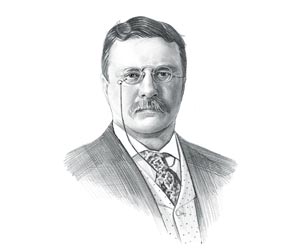|
|
|
|
|
Environmentalism encompasses a passion for nature and a conviction that humans are intruders who should be able to look, but not to interfere with, the environment. Environmentalism played an important part within Progressive Movement (1890 - 1920), that covered a wide range of social reform issues, and was closely associated with the Conservation Movement.
Difference between Conservation and
Environmentalism
Environmentalism History: President Theodore Roosevelt
American Environmentalism History for
kids:
The Early Environmentalism History - Causes
The Exploitation of Natural Resources in America without planning or foresight Soil erosion, and the mass movement of land and environmental degradation caused by the depletion of natural resources for profit Man's interference to the natural habitat of animals, birds and fish and the extinction or decline of wildlife The intrusion of man led to the near extinction of the buffalo that were killed for sport Human destruction of plants and trees, changes to natural water supplies and air pollution Changes to water supplies such as the damming of rivers for mills cut off natural water supplies and disturbed the natural habitat of animals Forest clearance resulted in further changes to river and stream flows that led a decrease in bird population which helped control insects and other pests Environmental degradation caused by the application of new inventions and advanced technology leading to pollution of the air and water Environmental degradation caused by the increase in human population increasing pollution, poverty and poor sanitation resulting in deadly epidemics
American Environmentalism History for
kids
American Environmentalism History for
kids:
Westward Expansion and Manifest Destiny
American Environmentalism History for
kids:
Transportation Systems
American Environmentalism History:
The Industrial Revolution
American Environmentalism History:
Industrialization
American Environmentalism History:
Urbanization
American Environmentalism History:
Immigration
American Environmentalism History for
kids:
The Progressive Movement
American Environmentalism History:
The Conservation Movement and the Environmentalists
American Environmentalism History Timeline for kids 1800: The start of the First Industrial Revolution in America 1811: Construction of Cumberland Road that begins in Maryland 1807: Steamboats revolutionized river travel and river trade. 1816: The American System creates a subsidized transportation infrastructure of new roads and canals in America 1821: Santa Fe Trail opens stretching 900 miles from Independence, Missouri, to Santa Fe (now New Mexico) 1825: Erie Canal opens stretching 363 miles and inspires a canal-building boom 1830: The American railroad era begins 1832: Hot Springs Reservation was the first area to be designated for government protection. 1836: Ralph Waldo Emerson defines the ideals of American conservation and Environmentalism in his 1836 essay entitled "Nature". 1840: The first settlers and wagon trains travel west on the 2000 mile Oregon Trail 1841: George Caitlin publishes Manners, Customs, and Condition of the North American Indians 1849: Policy of Westward Expansion is established together with the belief in Manifest Destiny 1850: The Hudson River School American art movement is established 1851: Henry David Thoreau delivers a speech declaring that "in Wildness is the preservation of the World." 1854: Henry David Thoreau publishes 'Walden' or 'Life in the Woods' 1860: The start of the Second Industrial Revolution and the Industrialization of America 1860's: The Rise of Big Business and corporations and the Robber Barons 1868: The Transcontinental Railroad was completed 1872: Yellowstone National Park is created by an Act of Congress 1875: John LeConte publishes his 'Journal of Ramblings through the High Sierra of California' 1880's: The Urbanization of America 1881: Immigration - Between 1881-1890 a total of 5,246,613 immigrants arrived in America. 1887: The Boone and Crockett Club is founded by Theodore Roosevelt and George Bird Grinnell. Its goal is to stem the loss of the nationís natural resources and to conserve wildlife habitat 1890: Congress passes legislation establishing Sequoia National Park and Yosemite and General Grant National Parks 1890: The start of the Progressive Era and increasing support for Environmentalism 1891: Congress passes the Forest Reserve Act 1892: John Muir founds the Sierra Club that is dedicated to the preservation of wilderness. 1893: Frederick Jackson Turner publishes "The Significance of the Frontier in American History." 1898: Gifford Pinchot is appointed chief of the Division of Forestry in the Department of Agriculture 1899: Conservationists and Environmentalists join the Harriman Alaska Expedition 1900: The Lacey Act becomes the first Federal law protecting game 1901: Theodore Roosevelt becomes president and announces his goals of forest conservation and preservation 1902: Congress passes a bill establishing Crater Lake National Park, Oregon. 1902: Congress passes the Alaska Game Act protecting animals in Alaska 1903: The first Federal Bird Reservation is established on Pelican Island, Florida 1903: Congress passes a bill establishing Wind Cave National Park, South Dakota. 1904: President Roosevelt announces his Square Deal Policy 1904: Law passed that leads to the establishment of Sullys Hill National Park, North Dakota. 1905 The American Bison Society is organized 1905: The American Forest Congress in Washington to discuss issues relating to natural resources to leaders of lumbering, mining, grazing, and irrigation industries 1906: The Game and Bird Preserves Protection Act is passed 1906: The National Monuments Act ( Antiquities Act) authorizing the President to establish national monuments for the preservation of historic, prehistoric, and scientific interest 1906: President Roosevelt establishes the Devil's Tower National Monument, Wyoming, as the nation's first National Monument 1906: Law establishes Mesa Verde National Park, Colorado, and Platt National Park, Oklahoma 1906: Congress passes by "An Act For the control and regulation of the waters of Niagara River, for the preservation of Niagara Falls, and for other purposes" 1907: Cinder Cone National Monument and Lassen Peak National Monument, California established 1908: The National Conservation Commission is formed 1908: Muir Woods National Monument, California is established 1909: Congress passes "An Act To create the Calaveras Bigtree National Forest" 1909: President Roosevelt issues a Proclamation establishing Mount Olympus National Monument, Washington. |
| US American History |
| 1881-1913: Maturation Era |
| The Conservation Movement |
| Famous Environmentalists |
|
|
|
|
|
First Published2016-04-19 | |||
|
Updated 2018-01-01 |
Publisher
Siteseen Limited
| ||
|
|

